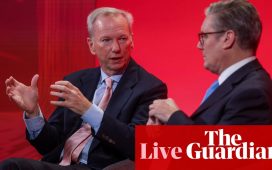Stay informed with free updates
Simply sign up to the UK inflation myFT Digest — delivered directly to your inbox.
UK inflation fell more than expected to a three-year low of 1.7 per cent in September, prompting the pound to fall and traders to increase bets on further rate cuts from the Bank of England this year.
Wednesday’s data release by the Office for National Statistics shows that inflation has come back under the BoE’s 2 per cent target for the first time since April 2021.
The annual increase in consumer prices is less than the 1.9 per cent forecast in a Reuters survey of economists and compares with August’s figure of 2.2 per cent. The retreat was driven by lower airfares and petrol prices.
The numbers will come as a boost to Sir Keir Starmer’s government just two weeks before what promises to be a tough Budget containing steep tax rises. Chancellor Rachel Reeves is looking to close a funding shortfall of £40bn, according to officials close to the Budget process.
The numbers led investors to increase bets that the BoE would lower interest rates for a second time in its November meeting following its quarter-point reduction in August, and then make an additional cut in December.
Traders had previously put the chance of two quarter-point rate cuts by the end of the year at roughly 50 per cent, according to levels implied in swaps markets. That increased to 75 per cent after the inflation release. The pound was down 0.6 per cent against the dollar at $1.30 on Wednesday.
A November cut already looked “nailed on before today’s release”, said Paul Dales at Capital Economics. “The chances of that being immediately followed by another quarter-point cut at the following meeting in December has just gone up,” he added.
Aaron Hussein, global market strategist at JPMorgan Asset Management, said the inflation data and cooling wage growth showed the BoE was “gradually taming the inflation tiger”.
The yield on two-year UK government bonds, which are sensitive to interest rate changes, fell 0.09 percentage points to 4.04 per cent.
Governor Andrew Bailey said recently that rate-setters could be “a bit more aggressive” in lowering borrowing costs if inflation continued to fall. The comments were seen by investors as a signal that the BoE was poised to cut rates at both its November and December meetings.
Core inflation was 3.2 per cent, lower than economists’ expectations of 3.4 per cent, while the rate of services inflation fell from 5.6 per cent to 4.9 per cent, driven by lower airfare price rises.
Services inflation is seen by the central bank as a key gauge of underlying price pressures. The 4.9 per cent reading was well below the 5.5 per cent forecast published by the BoE when it last released a full assessment of the economy in August.
It chimes with separate ONS data this week showing that UK wage growth fell to 4.9 per cent in the three months to August, down from 5.1 per cent in the three months to July.
The decline in services inflation is “big news” for the central bank, said James Smith, UK economist at ING. “We think the Bank of England can pick up the pace of cuts beyond November.”
An acceleration in the rate-cutting cycle is possible even though headline inflation is likely to bounce back towards 2.5 per cent later this year as the downward drag from lower energy prices fades, Smith added.
A key input into the BoE’s December meeting will be the shape of Reeves’s October 30 Budget and the impact of her attempts to get debt under control.
Darren Jones, the chief secretary to the Treasury, said Wednesday’s inflation figures would be “welcome news for millions of families”, adding that “there is still more to do to protect working people”.
However, the sharp drop in inflation will hit many lower-income families, given September’s 1.7 per cent figure is set be used to uprate working-age benefits next spring.














